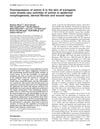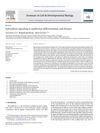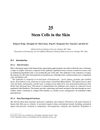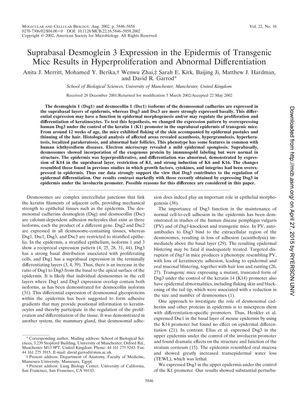TLDR Overexpressing Dsg3 in mice skin causes excessive cell growth and abnormal skin development.
The study investigated the effects of overexpressing human desmoglein 3 (Dsg3) in the suprabasal epidermis of transgenic mice, which led to skin flaking, epidermal pustules, hair thinning, and various histological abnormalities such as acanthosis, hypergranulosis, hyperkeratosis, localized parakeratosis, and abnormal hair follicles. These changes indicated hyperproliferation and abnormal differentiation of the epidermis, resembling features of human ichthyosiform diseases. The findings suggested that Dsg3 played a significant role in regulating epidermal differentiation, contrasting with previous results where Dsg3 was expressed under a different promoter.
195 citations
,
November 2001 in “The Journal of Cell Biology” Desmocollin 1 is essential for strong skin and proper skin function.
 204 citations
,
October 1999 in “EMBO journal”
204 citations
,
October 1999 in “EMBO journal” Overexpression of activin A in mice skin causes skin thickening, fibrosis, and improved wound healing.
32 citations
,
November 1998 in “Journal of Biological Chemistry” Mouse and human keratin 16 can both form filaments, with differences likely due to the tail domain, not the helical domain.
150 citations
,
April 1997 in “Journal of Investigative Dermatology” 94 citations
,
October 1994 in “The Journal of Cell Biology” Too much keratin 16 in mice skin causes abnormal skin thickening and structure.
265 citations
,
March 1993 in “The EMBO Journal” Keratinocyte growth factor significantly alters skin and tissue development.
409 citations
,
May 1991 in “Genes & Development” TGF-alpha affects skin thickness, hair growth, and may contribute to psoriasis and papilloma formation.
2 citations
,
September 2004 in “Experimental Dermatology” Desmosomal adhesion is essential for healthy skin structure and function.
 42 citations
,
October 2011 in “Seminars in Cell & Developmental Biology”
42 citations
,
October 2011 in “Seminars in Cell & Developmental Biology” Eph/ephrin signaling is important for skin cell behavior and could be targeted to treat skin diseases.
4 citations
,
January 2013 in “International Journal of Trichology” Desmogleins are crucial for hair structure and growth.
50 citations
,
February 2004 in “Genomics” A gene mutation causes lanceolate hair in rats by disrupting hair shaft integrity.

Skin stem cells are crucial for maintaining and repairing skin, with potential for treating skin disorders and improving wound healing.



